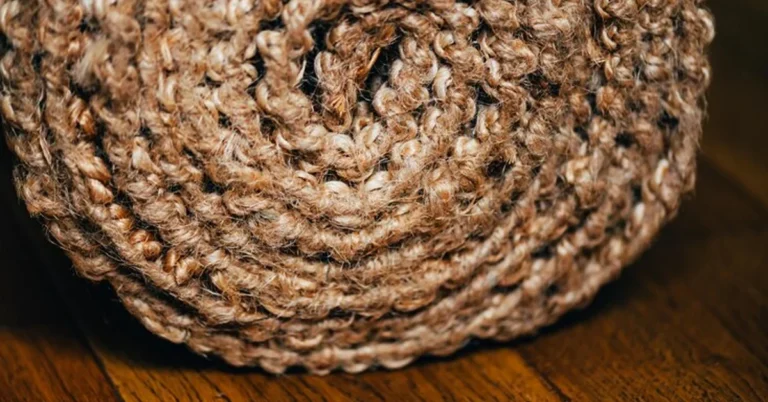In today’s world, as we grow increasingly aware of the environmental challenges we face, natural and sustainable materials have become crucial in various industries. One such material that has risen in popularity due to its eco-friendly nature is sisal. This natural fiber, extracted from the leaves of the Agave sisalana plant, is celebrated for its versatility, durability, and sustainable qualities. In this article, we will explore what sisal is, its numerous uses, environmental benefits, and why it is considered one of the best materials for sustainable living.
TRENDING
Top Basket Puns That Are Egg-cellent For Any Joke
What Is Sisal?
Sisal’s is a natural fiber that originates from the Agave sisalana plant, which is primarily grown in arid regions of Africa, Central America, and parts of Asia. The plant’s long, fibrous leaves are harvested and processed to extract the tough, durable fibers that are used in various applications. These fibers are known for their strength, resilience, and ability to withstand wear and tear, making them ideal for products that require durability.
Unlike synthetic fibers, which are derived from petroleum-based resources, sisal’s is biodegradable, making it a much more eco-friendly choice. Its production also involves minimal environmental impact, particularly when compared to the energy-intensive processes used for synthetic materials.
The History Of Sisal
Sisal’s has a rich history that dates back to the 19th century. It is believed to have originated in Mexico and was first cultivated in the region during the early 1800s. The fiber was named after the port of Sisal’s in Mexico, where it was first exported to the rest of the world.
In the early 20th century, sisal’s gained popularity as a vital material for making ropes, particularly for maritime use. As global trade expanded, so did the demand for sisal’s which became an essential raw material in many industries, including agriculture, construction, and textiles. Today, while it is still used in many traditional industries, its role in eco-friendly products has grown, especially as consumers become more environmentally conscious.
Properties Of Sisal Fiber
Before delving into the many uses of sisal’s it is essential to understand the properties that make this fiber so valuable:
Durability: Sisal’s fibers are incredibly strong and durable, making them ideal for high-stress applications such as ropes, mats, and carpets.
Resistance to Damage: Unlike other fibers, sisal’s is resistant to damage from UV rays and moisture. This makes it a great choice for outdoor products.
Biodegradability: As a natural fiber, sisal’s is completely biodegradable, meaning it won’t contribute to long-term pollution when disposed of properly.
Eco-Friendly: Sisal’s requires minimal water and pesticides to grow, making it a low-impact crop. It also helps in preventing soil erosion.
Flexibility: Sisal’s can be woven or braided into various forms, allowing for a wide range of uses from rugs to ropes.
The Environmental Benefits Of Sisal
Sustainability has become one of the most significant concerns for modern consumers and businesses alike. Sisal’s is often touted as a sustainable alternative to synthetic fibers for a number of reasons:
Low Water Requirements
Unlike cotton, which requires substantial water to grow, sisal’s is a drought-resistant plant that thrives in arid regions with minimal rainfall. This makes it an ideal crop for areas with water scarcity, and it significantly reduces the overall water footprint.
Reduced Carbon Footprint
The cultivation and processing of sisal’s require far fewer resources compared to synthetic materials, which often involve high carbon emissions. Additionally, sisal’s plants absorb carbon dioxide while growing, helping to offset emissions.
Soil Erosion Control
Sisal’s deep root system helps prevent soil erosion, especially in regions where land degradation is a concern. Its cultivation stabilizes the soil, making it valuable in reforestation and land reclamation projects.
Sustainable Harvesting
Sisal’s plants are relatively easy to harvest and do not require the use of chemical fertilizers or pesticides. The leaves of the plant are cut by hand, ensuring that the process has minimal environmental impact. Additionally, after the fiber is extracted, the remaining biomass can be used as animal feed, mulch, or even biofuel.
Uses Of Sisal
Sisal’s versatility means that it has a broad range of applications across different industries. From construction to fashion, sisal’s has established itself as an essential material for sustainable living. Below are some of the key uses of sisal:
Ropes and Twines
Historically, sisal’s has been used to make ropes and twines. These ropes are incredibly durable and resistant to damage from UV light and moisture, making them ideal for marine environments, agriculture, and industrial applications.
Flooring and Carpets
Sisal’s is commonly used in the production of rugs, carpets, and mats. The fiber’s natural texture gives these products a rustic yet elegant look. Moreover, sisal’s carpets are biodegradable and can be disposed of in an environmentally friendly way at the end of their lifespan.
Textiles and Fabrics
Sisal is also used in the textile industry to create strong, durable fabrics for various uses, including upholstery, clothing, and accessories. The fabric is eco-friendly and breathable, making it a great alternative to synthetic materials.
Composite Materials
In recent years, sisal has found its way into the automotive and construction industries as a reinforcement material in composite products. The fiber is used in the production of lightweight, durable parts that are both eco-friendly and cost-effective.
Packaging Materials
Sisal fiber is increasingly being used in sustainable packaging. It is an excellent alternative to plastic, providing a biodegradable solution for packaging products such as food, electronics, and other goods.
Sisal In The Fashion Industry
As consumers shift towards more sustainable and ethically sourced products, sisal has become a popular material in the fashion industry. Designers are incorporating sisal into their collections, particularly in accessories such as handbags, shoes, and belts. Sisal’s natural aesthetic and eco-friendly properties make it a standout material for those looking to reduce their environmental impact.
The fiber is often blended with other natural materials like cotton, jute, and hemp to create unique textures and patterns in fashion products. Moreover, sisal-based accessories are lightweight, durable, and easy to maintain, offering a great alternative to synthetic materials that are harmful to the environment.
How To Incorporate Sisal Into Your Sustainable Lifestyle
Integrating sisal into your daily life is an excellent way to support sustainable living. Here are a few ways to do so:
- Choose Sisal Rugs: Opt for sisal rugs or mats in your home instead of synthetic alternatives. They are durable, biodegradable, and aesthetically pleasing.
- Support Eco-Friendly Fashion: Look for fashion brands that use natural fibers like sisal in their products.
- Use Sisal Ropes: Choose sisal ropes for outdoor or gardening purposes. They are long-lasting and much more sustainable than plastic or synthetic ropes.
- Compost Sisal Products: When sisal products reach the end of their life, compost them to avoid contributing to landfill waste.
Conclusion
Sisal is more than just a natural fiber—it is an essential material for a more sustainable and eco-conscious future. From its minimal environmental impact during cultivation to its wide range of uses across various industries, sisal stands as a prime example of how nature can provide us with sustainable alternatives to synthetic materials. Whether used in home decor, fashion, or industrial applications, sisal is proving to be a versatile and eco-friendly choice for those who prioritize sustainability in their lives.
By incorporating sisal into your daily routine, you not only contribute to a greener planet but also embrace the beauty and durability that this incredible natural fiber offers. As we continue to shift towards more sustainable practices, sisal will undoubtedly play a key role in shaping a better future for both consumers and the planet.
ALSO READ: Barras Napoleon: The Power Struggle That Shaped France
FAQs
What is Sisal?
Sisal is a natural fiber derived from the Agave sisalana plant. It is known for its strength, durability, and biodegradability, making it an ideal material for various products, including ropes, rugs, and textiles. Sisal is grown in arid regions and requires minimal water, making it an eco-friendly alternative to synthetic fibers.
Is Sisal eco-friendly?
Yes, sisal is considered an eco-friendly material. It is biodegradable, requires little water to grow, and does not need chemical fertilizers or pesticides. Additionally, it is a sustainable alternative to synthetic materials, reducing the carbon footprint and environmental impact.
Can Sisal be used for carpets?
Yes, sisal is commonly used to make rugs, carpets, and mats. Its natural texture adds a rustic charm, and its durability makes it a popular choice for high-traffic areas. Sisal carpets are also biodegradable, providing an eco-friendly flooring option.
How strong is Sisal?
Sisal fibers are incredibly strong and durable. They are resistant to UV rays and moisture, making them ideal for ropes, mats, and other high-stress applications. The strength of sisal makes it suitable for both industrial and domestic uses.
Where is Sisal grown?
Sisal is primarily grown in arid regions such as parts of Africa, Central America, and Asia. The plant thrives in dry, sunny climates and requires minimal water, making it an ideal crop for areas with water scarcity.

